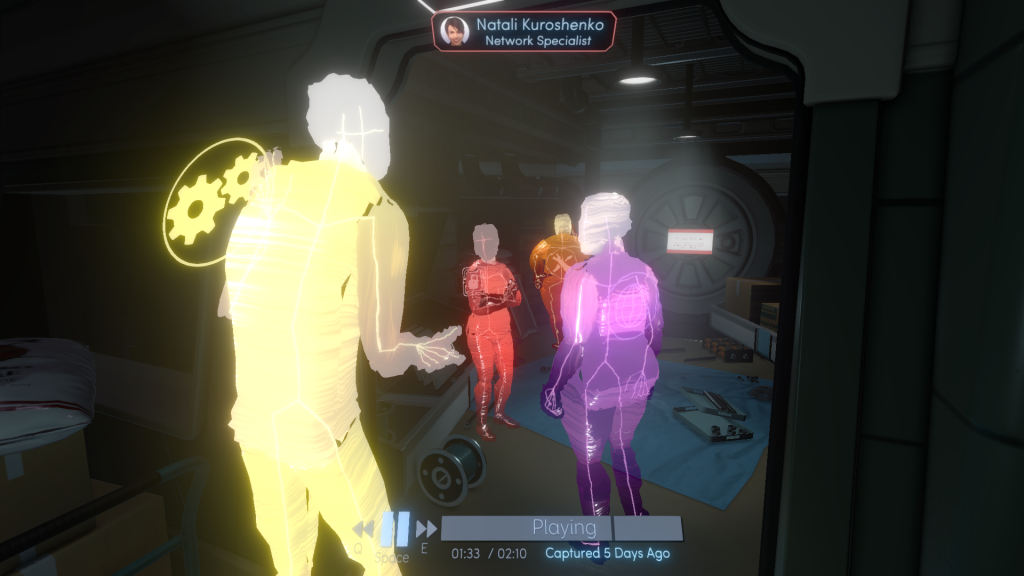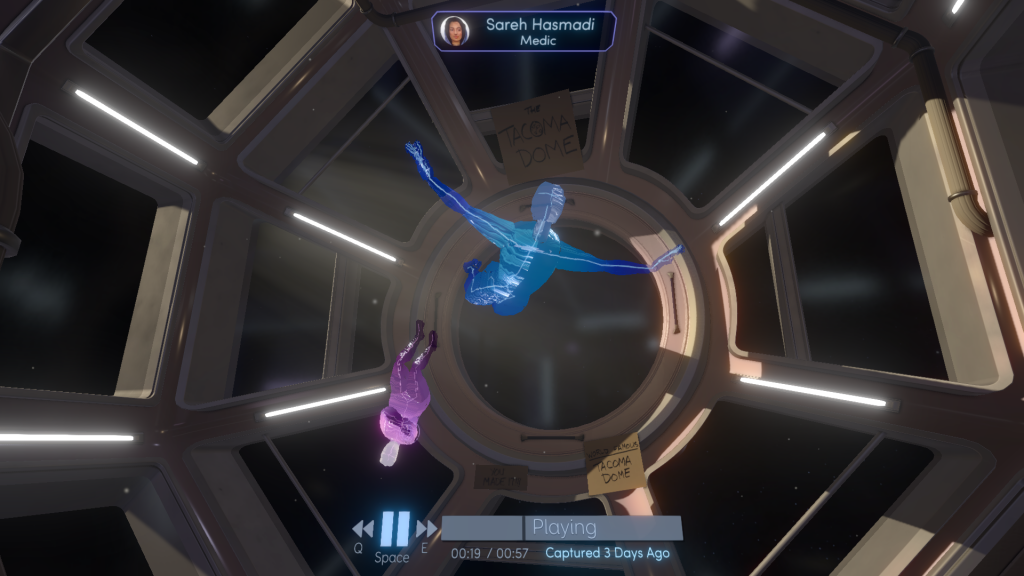An Interview with Fullbright’s Steve Gaynor (Tacoma, Gone Home)
William Hoffacker
Tacoma is the latest game from Fullbright, the independent studio that first released Gone Home. Both games feature a first-person p.o.v. player-character who explores an otherwise uninhabited environment, discovering a rich story by examining artifacts left by people who were once there. In Tacoma, that setting is an abandoned lunar transfer station (the titular Tacoma), and the player attempts to learn the fate of its absent crew by accessing AR recordings of their lives. Enter a new part of the station and a new scene appears in the form of walking, talking figures, which the player can then play, pause, rewind, and fast-forward. Sometimes you follow characters from one room to another as they converse; you might hear how one crew member talks about another behind her back, then differently to her face. The experience creates a whole new sense of what it means to call a game’s story “immersive.”
Steve Gaynor is one of the founders of Fullbright. Below, he talks with Cartridge editor William Hoffacker about Tacoma‘s development, his literary influences, and many games he recommends or looks forward to.
What were the greatest challenges of writing the story for Tacoma?
A lot of it was figuring out how to write a story in this way. The ability to rewind, fast-forward, and move through Tacoma’s story meant that we had to think about writing the core scenes totally differently from how we had in any other game we’d worked on, or any other game we’d played, really. But once we had a working prototype of the AR scene playback mechanics, and a layout for the spaces the scenes took place in, we could start building out all the narrative threads within each scene as we supported what was happening at each point in the story—and from there the process was pretty natural, just a lot of work, hah.
It seems to me that the first and foremost way that Tacoma’s story could fail is if the player did not care what happened to the crew. What did you do (for example, via the dialogue, or visual cues, or any aspect of the game’s early moments) to try to ensure that your audience would immediately feel some attachment to the characters and thus want to discover their fate?
The most important thing to us was to use the mechanics to allow the player to compare and contrast each character’s public vs. private self. The voyeurism of the AR scenes allows us to observe how the characters act when speaking to each other in a group, versus when speaking to each other in isolation, or how they behave when entirely on their own. We went for this early, for instance seeing EV’s take-charge nature with the crew in the debris impact scene, vs. her plaintiveness when back on her own in the bunk, or Clive’s gregarious banter with other members of the crew versus his private insecurities he shares with Germ. We hoped that this would allow the player to build a more complete picture of each of the characters as a fully realized individual, and build an attachment to them as a group of people they felt real empathy for.
The station’s AI, ODIN, is visually represented by a large, humanoid eye inside a floating, upside-down pyramid. This imagery seems meant to evoke symbols associated with God, government, Illuminati tales—all likely to make one feel uneasy. What did you have in mind when you designed ODIN to look this way? What kind of player-reaction did you intend this model to evoke?
ODIN, like many classic sci-fi AIs, is a presence whose true nature and motives are opaque to the player, especially at the start. The unknowability of AI is what makes them so fascinating. ODIN functions as a helper and coordinator on Tacoma, but he’s also always listening and watching—he’s directly tied to the digital surveillance that’s captured the 3D recordings you’re interacting with. So we wanted him to be an unblinking eye, and we wanted him to be a simple shape, an abstracted presence that could appear anywhere and interact with the crew. So that led us to the pyramidal all-seeing eye shape, flipped on its point to spin like a top. We also liked that, if you think of the iconic view of ODIN as being one side of the pyramid, ODIN is cycloptic, having one eye like the Norse god Odin, his namesake.
Can you please describe the research that you did in order to develop Tacoma? What kinds of texts did you read, and what types of people did you speak to?
We did research on a few different vectors. We researched accounts of living in orbit on the ISS, and of living in extremely remote facilities such as research bases in Antarctica, to understand the dynamics and details of people confined to these kinds of places for long periods of time. We read books such as An Astronaut’s Guide to Life on Earth by the astronaut Chris Hadfield, and various blogs and accounts by other astronauts and researchers. We also went back to a number of AI-themed science fiction novels and films, such as 2001, Moon, Alien, and even classic texts like Asimov’s I, Robot for inspiration and reference points. As far as talking to individuals, probably the most direct interview research we did was with people in our circles who grew up in the Muslim faith. We wanted to get our depiction of Sareh right, so we talked to folks we knew when conceiving her character, and then had them play through a build of the game once her scenes were built and her bunk set up to see if we’d missed anything. Luckily it seems that with their help we were able to represent Sareh in an authentic way!
What sorts of literature do you most enjoy reading? What books (or other texts) do you think had the most influence on the writing of Tacoma and/or Gone Home?
I guess I have a fair breadth in what I read, though I have to admit I don’t read a whole lot compared to some people. I’m just a slow reader and easily distracted; it’s my own fault. But I guess I read a fair amount of modern lit (David Foster Wallace, Cormac McCarthy, Alice Munro…) and some classic sci-fi and crime fiction (Philip K. Dick, Jim Thompson) as well as some comics and graphic novels (Chris Ware, Adrian Tomine, I enjoyed My Favorite Thing Is Monsters by Emil Ferris last year, and am re-reading some of my old Calvin & Hobbes books now…). I think that Alice Munro’s work as an author, and the TV show My So-Called Life were probably two of the most direct influences on Gone Home. Tacoma was probably more influenced by film and television: we drew from the crew of the Nostromo in Alien, and the vibe of Gerty from Moon, and the dynamic of McNulty’s unit from The Wire for how I thought about this group of misfits being thrown together and having to learn from each other and work within a system that’s bigger than any of them can comprehend. We were also deeply influenced by the immersive theater production Sleep No More, which is itself an adaptation/melding of Shakespeare’s MacBeth and Alfred Hitchcock’s Vertigo.
If someone played Tacoma and/or Gone Home and loved the experience so much that they just wanted more, more, more, what would you recommend they try next? (Such recommendations might include other video games to play, but please feel free to answer however you like: books, movies, music, even a long walk, etc.)
As far as games go, I could recommend playing through Minerva’s Den, the downloadable story content for BioShock 2 that Karla Zimonja, my story partner and studio co-founder, and I led together before we went indie to make Gone Home. It’s equal parts tragic romance and AI tale, and kind of forms a trilogy with Gone Home and Tacoma. I’d also suggest some other games in the first-person story subgenre, like The Beginner’s Guide by Davey Wreden or Firewatch by Campo Santo. There’s a free game I really love called Packing Up the Rest of Your Stuff on the Last Day at Your Old Apartment, which is about just what it sounds like, and is a simple and beautifully-crafted melancholic little game that’s well worth playing. I also loved this year’s Butterfly Soup, a visual novel-style game about a group of queer Asian teenagers who all love baseball. It’s incredibly funny, personal, and touching. I’d also suggest Building Stories by Chris Ware, a book collection that follows the story threads of one small apartment building in Chicago, and the people who live and die there. It’s incredibly inventive, beautiful, and heartbreaking, like so much of Ware’s work, and speaks to the personal and environmental style of storytelling that we focus on.
If you could adapt any literary work into a video game (of any type, any scale), what work would you choose, and what might that game look and play like?
I think I’d adapt Runaway or The Lives of Girls and Women by Alice Munro. The sense of place and time and personal experience and the beauty with which Munro gives the reader a view into her characters’ lived experience is so vivid and so small that it feels just incredibly human. I’m not sure what the game would look or play like, but I just imagine how inhabiting those spaces and living through those moments could be really incredible.
What new games are you most anticipating right now? (Answers might include not only upcoming releases but also games already out that you haven’t gotten to play yet.)
Right now I hardly even have my eyes on the horizon as far as upcoming releases go. I’m still working on my backlog just from 2017. I played a ton of amazing stuff this year, but there are indie titles I still need to get to (Detention, Everything Is Going to Be OK, Opus Magnum, Heat Signature, Mortician’s Tale) and some AAA games I haven’t spent enough time with either (not far into the new Mario, though I did manage to finish the main quest in Zelda…). Conceptually, I loved Resident Evil 7 a lot and I can’t wait to see where they go next after the huge shift that game was from prior entries in the series. Far Cry 5 seems like it’s going into some intense territory with the new title and I’m really interested to see how that turns out. I’m incredibly intrigued to see what they do with The Last of Us Part 2. Above all, I’m excited to see what new and unexpected indie and AAA games come out of nowhere to surprise us and give us experiences we’d never anticipated.


